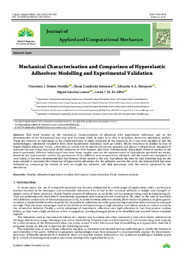Please use this identifier to cite or link to this item:
https://hdl.handle.net/11000/33437Full metadata record
| DC Field | Value | Language |
|---|---|---|
| dc.contributor.author | Simon Portillo, Francisco J. | - |
| dc.contributor.author | Cuadrado Sempere, Óscar | - |
| dc.contributor.author | Marques, Eduardo A.S. | - |
| dc.contributor.author | Sánchez Lozano, Miguel | - |
| dc.contributor.author | da Silva, Lucas F.M. | - |
| dc.contributor.other | Departamentos de la UMH::Ingeniería Mecánica y Energía | es_ES |
| dc.date.accessioned | 2024-10-07T09:10:22Z | - |
| dc.date.available | 2024-10-07T09:10:22Z | - |
| dc.date.created | 2021-11 | - |
| dc.identifier.citation | Journal of Applied andComputational Mechanics, 8(1) (2022) 359-369 | es_ES |
| dc.identifier.issn | 2383-4536 | - |
| dc.identifier.uri | https://hdl.handle.net/11000/33437 | - |
| dc.description.abstract | This work focuses on the mechanical characterisation of adhesives with hyperelastic behaviour, and on the determination of the behavioural laws that best represent them, in order to be able to introduce them into simulation models. There are virtually no references to the characterisation of these materials in the literature, so it has been decided to use the methodologies commonly employed with other hyperelastic materials, such as rubber, whose behaviour is similar to that of highly flexible adhesives. Firstly, a test plan is carried out on simple specimens, uniaxial and planar configurations, designed to measure the non-linear behaviour of the adhesives in both tension and shear. Subsequently, using finite element models of the tested specimens, different behavioural laws from those usually used for the representation of hyperelastic materials are tested. Based on the experimental results, the parameters of the different laws proposed are adjusted, and the results are compared. In conclusion, it has been determined that the Mooney-Rivlin model is the one that allows the best fit, and therefore may be the most suitable to represent the behaviour of hyperelastic adhesives. For the adhesive used in this work, the obtained law has been validated by comparing the results of tests on single lap adhesive join (SLJ) specimens with the results predicted by the simulation. | es_ES |
| dc.format | application/pdf | es_ES |
| dc.format.extent | 11 | es_ES |
| dc.language.iso | eng | es_ES |
| dc.publisher | Shaid Chamran University of Ahvaz | es_ES |
| dc.rights | info:eu-repo/semantics/openAccess | es_ES |
| dc.rights | Attribution-NonCommercial-NoDerivatives 4.0 Internacional | * |
| dc.rights.uri | http://creativecommons.org/licenses/by-nc-nd/4.0/ | * |
| dc.subject | Flexible adhesive | es_ES |
| dc.subject | Hyperelastic models | es_ES |
| dc.subject | Mechanical characterisation | es_ES |
| dc.subject | Finite element analysis | es_ES |
| dc.subject.other | CDU::6 - Ciencias aplicadas::62 - Ingeniería. Tecnología | es_ES |
| dc.title | Mechanical Characterisation and Comparison of Hyperelastic Adhesives: Modelling and Experimental Validation | es_ES |
| dc.type | info:eu-repo/semantics/article | es_ES |
| dc.relation.publisherversion | https://doi.org/10.22055/JACM.2021.38119.3242 | es_ES |

View/Open:
JACM_Volume 8_Issue 1_Pages 359-369.pdf
1,8 MB
Adobe PDF
Share:
.png)
